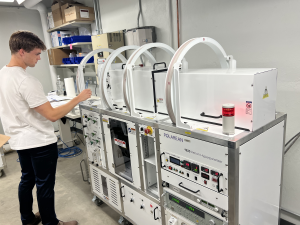Student: Jonathan Percy, Undergraduate Student in Applied Physics Emphasis in Computer Science/Pre-Medicine, University of Iowa
Research Mentor: Sean Fain
Novel Applications of Hyperpolarized 129Xe Magnetic Resonance Imaging
 Medical imaging serves a crucial role in establishing diagnosis, determining severity, monitoring progression, and uncovering the pathophysiology associated with many diseases. This research, led by Dr. Sean Fain, explores novel applications of hyperpolarized (HP) 129Xe magnetic resonance imaging (MRI) in populations including those suffering from Long Covid, cystic fibrosis, interstitial lung disease, and radiation-induced pulmonary changes associated with radiation therapy. This technique differs from standard imaging practices today while measuring lung function more directly than conventional pulmonary tests delivering quantitative measures of ventilation, perfusion, and gas exchange of the lungs. After more research, these novel biomarkers could possibly guide adjustments to treatment and deployment of potential therapies to improve outcomes.
Medical imaging serves a crucial role in establishing diagnosis, determining severity, monitoring progression, and uncovering the pathophysiology associated with many diseases. This research, led by Dr. Sean Fain, explores novel applications of hyperpolarized (HP) 129Xe magnetic resonance imaging (MRI) in populations including those suffering from Long Covid, cystic fibrosis, interstitial lung disease, and radiation-induced pulmonary changes associated with radiation therapy. This technique differs from standard imaging practices today while measuring lung function more directly than conventional pulmonary tests delivering quantitative measures of ventilation, perfusion, and gas exchange of the lungs. After more research, these novel biomarkers could possibly guide adjustments to treatment and deployment of potential therapies to improve outcomes.